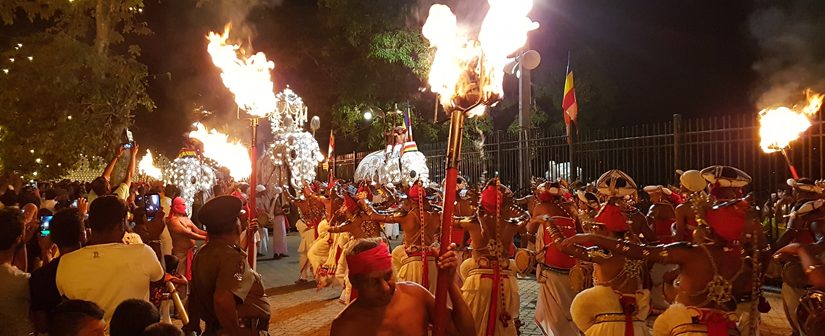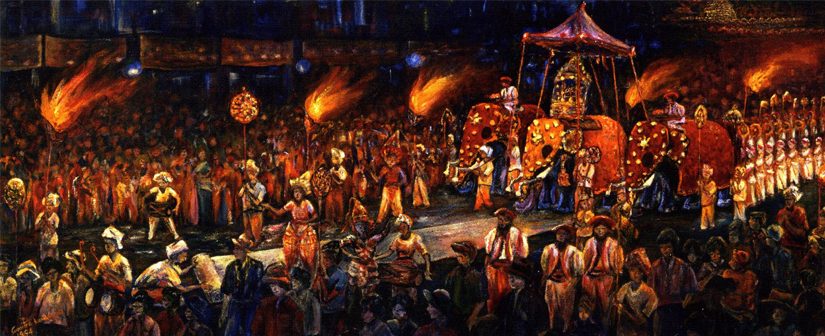If you’re in Sri Lanka on Wednesday 14 August 2019, then you’re in luck – it’s the day of the main procession of this year’s colourful Kandy Perahera, featuring elephants, acrobats and fire eaters.
How to watch the Perahera

The procession goes around the streets of Kandy, thus you can watch it from many places in the town. But if you’d like to be seated, you could book online tickets at. It’s secure and fast. A booking and website by the Temple of the Tooth Relic.
The background of the Kandy Perahera
The Modern Perahera dates back to the reign of the Kandyan King Kirthi Sri Rajasinghe (1747 – 1781 AD). In that era, the Tooth Relic was considered the private property of the King. No one apart from the Royal Family was allowed to see or worship the Tooth Relic. However, King Rajasinghe decreed that the Relic be taken in procession for the masses to see and venerate.

With the fall of the Kandian Kingdom in 1815, the custody of the Relic was handed to the Buddhist Clergy. In the absence of the king, a lay custodian called the “Diyawadana Nilame” was appointed to handle routine administrative matters.
The Temple of the Tooth is a great place to understand the history of the Kingdoms and the Tooth Relic. Read Sri Lanka holiday Guru’s guide on visiting the temple
Understanding the Kandy Perahera
The Kandy Esala Perahera begins with sanctifying young a Jackfruit tree which is cut and planted in the premises of each of the four Buddhist Temples (called Devales in Sinhala) dedicated to the four guardian Gods Natha, Vishnu, Katharagama and the Goddess Pattini. As a traditional sign meaning to get the blessings of the Gods to the King and the people.
The Order of the Kandy Perahera.
The Perahera procession is broken into main five sections representing the Five God and their temples, thus:
- The Dalada Maligawa Perahera (Perahera of the Temple of the Tooth)
- Natha Devale
- Vishnu Devale
- Katharagama Devale
- Pattini Devale
For five nights, the “Temple Peraheras” takes place within the premises of the four Temples accompanied by traditional music, drumming, flags and canopy bearers, spearman and the Ran Ayudha – the sacred insignia of the Gods.
On the sixth night, the Kumbal Perahera begins and continues for five days. Initially, the Temple Peraheras assemble in front of the Temple of the Tooth, which is Sri Lanka’s most important Buddhist Shrine and where the Buddha’s Sacred Tooth Relic has been kept since the 16th Century) with their insignias placed on the Ransivige (a dome-like structure) accompanied by the Basnayake Nilames – (the lay custodians of the Temples).
- The Dalada Maligawa Perahera (Perahera of the Temple of the tooth)
The relic casket, which carries a replica of the actual Tooth Relic, is placed inside the Ransivige affixed to the Maligawa Elephant, a tusker. At about 20.00, the Dalada Maligawa Perahera joins the awaiting other Devale Peraheras and leads the procession.
Whip-crackers and fireball acrobats clear the path, followed by the Buddhist flag bearers. Then, riding on the first elephant comes the official called Peramuna Rala (Front Official). He is followed by Kandyan Drummers and Dancers who enthral the crowd, and are themselves followed by elephants and other groups of musicians, dancers and flag bearers. A group of singers dressed in white heralds the arrival of the Maligawa Tusker carrying the Sacred Tooth Relic. The Diyawadana Nilame (traditionally required to do everything in his power to ensure rain in the correct season) walks in traditional Kandyan-clothed splendour after the tusker.
- Natha Devale Perahera
The second procession is from the Natha Temple, which faces the Sri Dalada Maligawa and is said to be the oldest building in Kandy, dating back to the 14th Century.
The Natha Devale’s location be found on Sri Lanka holiday Guru’s guide on visiting the temple of the Tooth Relic
- Vishnu Devale Perahera
The third is from the Vishnu Temple (Vishnu is a God of the Hindus), also known as the Maha Devale (The Big Temple). It is situated in from of the main gate of the Natha Devale.
- Katharagama Devale Perahera
The fourth procession is from the Katharagama Devale (dedicated to the God of Katharagama, identified with the warrior God Skanda) which is on Kottugodalle Vidiya (a street in Kandy). This procession includes Kavadi, the peacock dance, in which the pilgrim-dances carry semicircular wooden contraptions studded with peacock feathers on their shoulders.
- Pattini Devale Perahera
The fifth and final procession is from the Pattini Temple (Pattini being a Goddess associated with the cure of infectious diseases and called upon in times of drought and famine), which is situated to the West of the Natha Temple. This would the only procession that has women dancers.
Important times are announced by the firing of cannons
The following important times are announced by the firing of cannons, which can be heard all across Kandy.
- The commencement of the Temple Perahera
- The placing of the casket on the tusker’s back
- The commencement of the Dalada Perahera
- The completion of the Perahera
Read – 10 things to do in Kandy beyond the temple of the tooth relic
If you missed the Perahera this year, there’ll be another chance to witness it in August 2020.
Sri Lanka Holiday Guru Tip
The ceremony starts from the temple and takes a while to work its way through the town. It’s advisable to get to your seats or waiting for a spot early. Once the Procession starts the town gets crowded and movement will be restricted by the authorities.
Be extremely careful about your personal belongings. Carry your water bottles and snacks.
If you’re in a free public viewing area bear in mind that you might be jostled for space.
If you’re photographing be aware of the surroundings, as there could be open fire carried around for light and elephants’ movements.
Before and after the Perahera, traffic movement will be restricted within the city which might require you to walk back to the hotel or walk beyond the city centre to hail a taxi.




